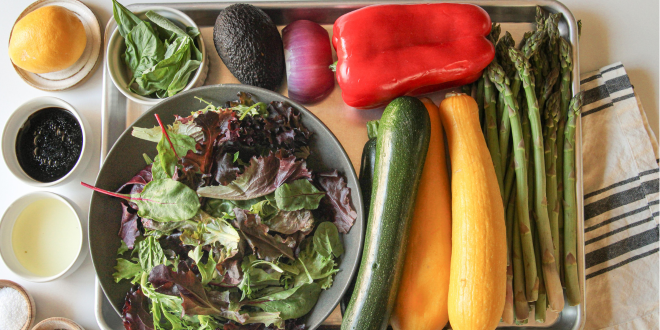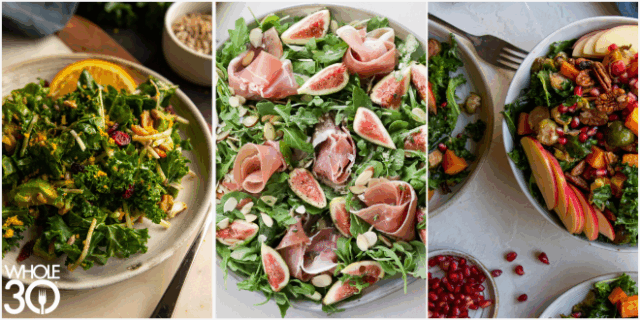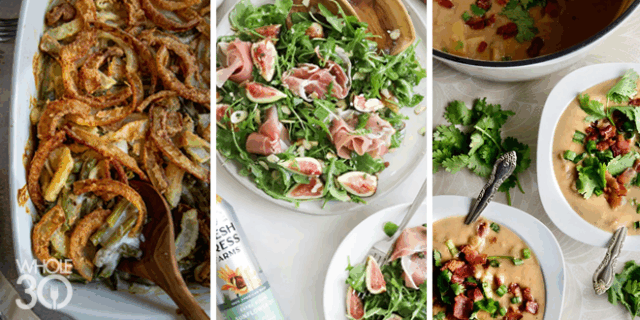At the start of a Group Whole30 month—January, May, or September—I spend a lot of time talking about meal planning. These big Whole30 moments are the perfect opportunity to highlight my favorite “ingredient meals.” These aren’t technically recipes, but they are the foundation for dozens of delicious Whole30 meals that let you cook once and eat multiple times. Think of them like Whole30 meal blueprints, requiring little to no measuring, tons of flexibility in terms of ingredients, and an awesome variety for several days’ worth of food… with just one prep and cooking session.
Though these ingredient meal blueprints are simple and intuitive, many of you still ask, “How do I get started, and what are some of the ingredient combinations you like the best?” I want nothing more than to see you succeed, and these meal blueprints are such a game-changer, they should not be gatekept. Here are three of my favorites!
Ingredient Meals, Blueprint 1: Eggs ‘n Things
This blueprint works for breakfast, lunch, and dinner. Mix, match, prep, and eat to your heart’s content—and build some kitchen confidence while you’re at it.
You’ll need:
- Eggs
- Diced veggies (cooked or uncooked)
- Diced meats (cooked)
- Herbs and spices
- Sauces, dressings, and condiments
Eggs: Crack a dozen eggs into a bowl and scramble with a fork.
Veggies: Take anything you have on hand (leftovers, frozen, canned) and rough-chop or small-dice. (The key is making them roughly all the same size.) If your veggies are fresh, you don’t need to pre-cook them. (If they’re already cooked, like leftovers, that’s fine too.) For frozen veggies, thaw them and drain any excess water, but don’t cook. If they’re canned, drain them of water. Once chopped or diced, mix into the eggs.
Meats: For additional protein, use any compatible pre-cooked meat (roasted chicken, pork or chicken sausage, bacon, ham, salmon, ground meat, or a plant-based alternative like Abbott’s Butcher plant-based “chorizo” or ground “beef”). Small dice or rough-chop if needed, then mix into eggs and veggies.
Herbs or spices: Throw in a compatible spice blend, individual spices (like salt, pepper, cayenne, garlic powder, or onion powder), fresh herbs, and/or a compatible hot sauce. (Pour some right into the egg mixture and stir to combine.) Add to taste—you can always add more upon serving.
Cook: Preheat your oven to 350°F. Grease a 9×12” glass baking dish with a compatible cooking oil spray, coconut oil, or ghee (coat bottom and sides thoroughly). Add the egg mixture and bake for 25-30 minutes, or until eggs are cooked through in the middle. (The time will depend on how much stuff you put into the mix. Use a chopstick in the center of your egg bake to ensure the eggs are cooked through.) Allow 5-10 minutes to cool before slicing and serving.
If you’re making egg muffins, grease each muffin tin thoroughly, or use paper baking cups. With a 1/3 measuring cup, pour the egg mixture into each muffin cup. Fill about ¾ full, as they’ll expand as they bake. Bake at 350°F for 20-25 minutes, or until eggs are cooked through in the middle. Allow 15 minutes to cool before removing from the tin.
Serve: Add a compatible dressing or sauce on top to taste. Try fresh salsa, guacamole, Ranch, or your favorite hot sauce. Serve with a side of greens and Whole30 ApprovedⓇ dressing, fresh berries and sliced avocado. Egg muffins also make for an easy grab-and-go breakfast or lunch.
Tips and tricks
- Egg muffins freeze beautifully. Wrap them individually in cling film tightly enough so air doesn’t dry them out.
- If you want extra variety, fill half the muffin cups with an ingredient mix of your choosing, then fill the remaining cups with a different mix of ingredients. This is a great way to use up the last of the veggie or protein scraps, while giving you two different varieties of muffins from the same prep session.
- Frozen veggies are a quick and cost-effective option, but avoid using watery veggies like zucchini or squash. Try carrots, broccoli, peas, cauliflower, or butternut squash instead. Thaw thoroughly and drain or pat away excess moisture before mixing in with the eggs.
- If you want an extra-thick frittata or muffin, add 2 tablespoons of almond flour to the egg mixture, then stir. If you want an extra creamy frittata, you could add the same amount of unsweetened, plain nutpods or coconut milk to the batter. (Don’t add liquid to egg muffins, however—you want them sturdy.)
Ingredient Meals, Blueprint 2: Ground Meat with Stuff over Stuff
Ground Meat with Stuff Over Stuff ™ is perhaps my most famous ingredient meal. It’s on rotation weekly at my house, because it’s easy, versatile, and delicious. This one allows you to cook once and eat 3-4 delicious, varied meals throughout the week. It’s a great and effortless way to combat meal boredom.
You’ll need:
- Ground meat
- Diced veggies
- A veggie base
- Herbs and spices
- Sauces, dressings, or condiments
Ground meat: Use ground chicken, turkey, beef, bison, elk, lamb, or pork. Cook 1-2 pounds of meat at a time, depending on how many people you’re cooking for. (Plan for leftovers—that’s the whole point.) You could also use plant-based Abbott’s Butcher “chorizo” or ground “meat” here since it’s Whole30 Approved.
Diced veggies: Use any veggies you happen to have on hand—you can’t get this wrong. Leftovers or scraps, frozen veggies, or jarred/canned veggies work great here, too. Dice or chop them all around the same size so they cook evenly.
Base: This is what you’ll put your ground meat + veggie mixture in or over. You can use anything from salad greens to jicama “taco” shells to sturdy lettuce wraps. Serve it over mashed, riced, or spiralized veggies like sweet potato, butternut squash, or cauliflower. It’s a way to add a bit more texture, substance, and nutrient-density to the meal.
Sauce: This is where all the flavor comes from, so get creative here! Any compatible dressing, sauce, condiment, and/or spice mixture can totally change the flavor profile of the meal. Think pasta sauce, salad dressing, mustard or ketchup, salsas, hot sauces, spice blends, guacamole, or curry sauce.
Cook: Drizzle some cooking oil into a non-stick pan on medium heat. You’ll want more cooking oil for lean cuts (like ground turkey or chicken breast) and less for fattier cuts (like 80/20% ground beef). Once your pan is warm, add your ground meat, and season with salt and pepper. Stirring occasionally, break up the meat with a spatula. Cook until browned (or until there is no longer pink in the meat). Transfer to a large bowl.
In the same pan, add your diced veggie mixture. (You may need to add more cooking oil here.) Saute, stirring occasionally, until crisp-tender. Remove from the pan and add your veggies to the bowl with the ground meat. Stir to combine.
Cook or prepare your veggie base. (You can do this ahead of time, or while your ground meat and veggies are cooking.) Leftovers work great here too.
Serve: Plate your base, then add a scoop or two of your ground meat + veggie mixture over the top. Add your seasoning, fresh herbs, dressing, and/or sauce, then serve.
Store: Store the unseasoned leftover ground meat + veggie mixture in the fridge. Swap out your base and toppings for your next meal to give the dish a totally new flavor profile.
Combos I love
I wouldn’t call these “recipes,” but these are the combinations I cook the most. Remember, flexibility is the point with these Whole30 meal blueprints, so use whatever you have on hand.
Combo 1: Ground beef + bell pepper + sweet onion + zucchini + sliced mushrooms + spinach or kale; served over cauliflower rice; topped with your favorite compatible Ranch.
Combo 2: Ground chicken breast + artichoke heart + kalamata olives + sun-dried tomatoes + roasted red peppers; sprinkle of thyme and parsley; over chilled, fresh greens (like baby spinach or arugula); topped with a compatible Balsamic dressing. (Serve the meat and veggies warm or cold.)
Combo 3: Ground bison or elk + bell peppers + onion + jalapeño + grape tomatoes; over thickly sliced, roasted sweet potato rounds; drizzled with a healthy portion of Primal Kitchen Classic BBQ Sauce and coconut aminos; sprinkled with diced red onion.
Combo 4: Ground pork + green peas + broccoli + mushrooms + carrots + green onion; over steamed zucchini noodles; topped with a compatible curry sauce or almond/cashew butter sauce.
Tips and tricks
- The ground meat + veggie mixture makes for an easy breakfast! Reheat and top with a fried egg, drizzle with your favorite compatible hot sauce, and add a side of sliced avocado (skip the base here).
- I can usually prep and cook the base in around 15 minutes, but plan ahead if you want to bake potatoes or roast spaghetti squash. I often chop the veggies while I’m browning the ground meat to save time.
- If you’re using jarred or canned veggies, drain them well to avoid excess water in the mixture. Also choose frozen veggies carefully—I use frozen peas, carrots, and diced butternut squash often, as those are far less watery than frozen zucchini or other squash.
- If you’re throwing potatoes into the mix, remember these take a lot longer to cook than peppers and onions. Your best bet is to roast them ahead of time, then toss into the mixture fully cooked at the very end.
- Spice mixtures and blends are another quick and easy way to add flavor. Just serve a portion of ground meat + veggies first, then add spice to each meal individually. This helps keep the mixture in your fridge versatile.
- Get creative with your sauces, and don’t be afraid to double up! (One of my favorites is a compatible Ranch + Buffalo sauce.) You can also use salsa or guacamole, fresh herbs, seasoned salts, nutritional yeast, or chopped and roasted nuts to add flavor before serving.
Ingredient Meals, Blueprint 3: Protein Salad
This hearty “salad” is my go-to lunch, as it travels well. It’s also perfect for “emergency protein” in your fridge at home, when you need a meal in a hurry. Using canned meats is also a budget-friendly option.
You’ll need:
- Diced or canned protein
- Diced veggies
- Sliced, diced, or whole fruit
- Nuts and seeds
- Base (optional)
- Flavor boosters
Protein: Use canned meat (salmon, tuna, or chicken), diced hard-boiled eggs, or cooked and diced chicken breast or salmon.
Veggies: Use raw veggies like carrots, celery, bell peppers, onion, jicama, snap peas, or pickles. You can also incorporate heartier cooked veggies like roasted sweet potato, broccoli, or asparagus.
Fruit: Use firm fruits like blueberries, strawberries, mandarin oranges, apples, pears, grapes, or pineapple. You can also use raisins, or compatible dried fruit (cranberries, cherries, mango) for an extra pop of sweetness.
Nuts and seeds: You can use anything but peanuts on the Original Whole30! Dice, chop, slice, your walnuts, pecans, almonds, or cashews, or add whole sunflower seeds or pine nuts. Don’t forget seeds like chia, hemp, or flax for texture and crunch.
Base: If you want to serve your protein salad on a base, try fresh greens, a hollowed-out bell pepper, a firm collard green wrap, a jicama round, or the inside of a tomato for a pretty presentation.
Flavor boosters: A good protein salad is excellent on its own, but you can add flavor in a ton of spots. Mix your protein base with Whole30-compatible Dijon, hot sauce, coconut aminos, or BBQ sauce. Crumble in a Whole30-compatible crispy cooked bacon or prosciutto. Add fresh herbs or spice blends. Top with a drizzle of your favorite compatible dressing or sauce.
Cook: If you’re using canned meat, pop three cans into a large bowl. If you’re using hard-boiled eggs, dice 8-12 boiled eggs. If you’re using leftover cooked chicken or salmon, small dice or shred one pound. Add Whole30-compatible mayo (or our DIY version) to make it as creamy as you like. Add an acid (like apple cider vinegar, rice vinegar, white vinegar, or lemon juice) to taste. Salt and pepper, then mix thoroughly.
If you want specifics, a good rule of thumb is 1 pound meat (or 8 hard-boiled eggs) + ¼ cup mayo + 2 tablespoons of acid. However, some folks like a really creamy mixture, while others prefer a drier texture. It also depends on how much stuff you add—the more veggies, fruit, nuts, seeds, etc., the more mayo and acid you might want to blend it all together. It’s easy to mix it all up, then add more—it’s harder to make it less creamy or acidic.
Dice your cooked or raw veggies. You want a medium dice here—not so small it all blends in, but not so big that you’re biting into huge chunks. Add to the bowl with the protein mixture and stir to combine.
Dice or add your fresh or dried fruit. If you’re using watery fruit (like pineapple), drain well before adding. Add to the bowl and stir to combine.
Chop and dice your nuts and seeds (if using) and add them to the bowl, stirring to combine. Add flavor boosters to the mix if desired, or save them for the top.
Prepare your base.
Serve: Plate your base, then add a scoop or two of protein salad on top. Add your dressing and sauce, flavor boosters, or toppings (like fresh herbs or slivered almonds), and serve.
Store: Store the leftovers in a glass storage container. This does not freeze well, so eat within 3-4 days of preparing.
Combos I love
Here are some of my favorite protein salad combinations. These aren’t recipes you need to follow, just use them for inspiration as you mix and match your way to a delicious lunch or midday mini-meal.
Combo 1: Canned chicken + sun-dried tomatoes + chopped black olives + capers + celery + chopped walnuts + fresh basil + cracked black pepper; over baby spinach with a drizzle of Whole30-compatible Greek dressing.
Combo 2: Canned salmon + rice vinegar and a splash of coconut aminos + bell pepper + green onion + pineapple + shredded carrots + slivered almonds; over chopped romaine lettuce with a drizzle of Whole30-compatible Sriracha, chili crisp, or no-soy Teriyaki.
Combo 3: Canned tuna + compatible Dijon mustard + celery + grapes + apple + red onion + pecans + green onion; served in jicama “wraps” with a drizzle of Whole30-compatible Balsamic dressing.
Combo 4: Shredded roasted chicken + hot sauce + roasted white sweet potato + blueberries or diced green apple + celery + chopped cashews; served on roasted sweet potato rounds; drizzled with compatible Buffalo sauce and Ranch.
Tips and tricks
- Canned meat offers a convenient and cost-effective way to pull this staple meal together. Read your labels or look for Whole30 Approved Safe Catch for seafood.
- You can use mayo, mustard, or mashed avocado for your creamy base.
- If you want maximum variety during the week, portion your protein/mayo/acid into two bowls. Mix half the protein using one set of ingredients, and the other using a different set.
- If you’re using jarred or canned veggies, drain them well to avoid excess water in the mixture.
- Compatible spice mixtures and fresh herbs are quick and easy ways to add flavor.
- Get creative with your sauces, and don’t be afraid to double up, like a splash of compatible Ranch and Buffalo sauce. You can also use salsa or guacamole, fresh herbs, seasoned salts, nutritional yeast, or seeds to add texture and flavor before serving.
Thanks for following along as I shared my fun and easy Whole30 ingredient meal blueprints! Tag me @melissau and @Whole30 in your creations and share your favorite combos with the community.
If you want more Whole30 tips, tricks, and support—as well as more articles from me—delivered to your inbox, subscribe today to receive Whole30 emails.
















